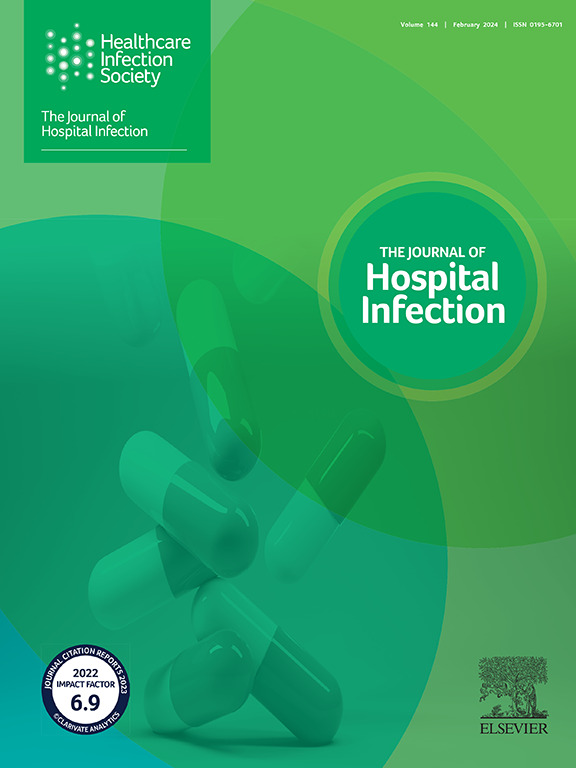The role of air pressure transients on the spread of bacteria from wash-hand basin sink traps in hospital en-suite bathrooms: a laboratory-based pilot study
IF 3.1
3区 医学
Q1 INFECTIOUS DISEASES
引用次数: 0
Abstract
Background
There is growing evidence for the involvement of sink and wash-hand basin traps in the spread of hospital-acquired infections in clinical settings. This pilot study used a full-scale model of a hospital wash-hand basin and wastewater drainage system, typical in single-occupancy hospital bathrooms, to examine bacterial transmission from sink traps to wash-hand basins during drainage system air pressure surges.
Methods
Simulating real-world conditions in a laboratory, a 50-m pipe network was connected to the model en-suite bathroom. Air pressure surges were generated within the pipe connection to the sink trap containing Pseudomonas alloputida KT2440 as a safe model bacterium. Measurements were made of air pressure, aerosol levels, and viable bacterial counts of the sink appliance using contact plates.
Results
Positive air pressure surges allowed water from the sink trap containing P. alloputida KT2440 to enter the wash-hand basin. Positive air pressure surges generated aerosols above the sink trap strainer. The strainer became contaminated without visible water ingress. Aerosols formed even without visible water, indicating sub-strainer agitation. Bacteria from the sink trap spread to surfaces, with viable cells recovered. Pressure surges occur naturally and increase with activities such as drain jetting.
Conclusions
For the first time, it was shown that air pressure surges in wastewater drainage systems can spread bacteria from contaminated sink traps to wash-hand basins, particularly via aerosols. This emphasizes the need for a re-examination of hospital wastewater drainage system design and maintenance in order to mitigate this mechanism of contamination.
气压瞬间对医院套间浴室洗手盆水槽细菌传播的作用:一项基于实验室的试点研究。
背景:越来越多的证据表明,水槽和洗手盆陷阱与临床环境中医院获得性感染的传播有关。本试点研究使用了医院洗手盆和污水排水系统的全尺寸模型(典型的单人医院浴室),以检查在排水系统空气压力激增期间,细菌从洗手盆到洗手盆的传播。方法:模拟实验室中的现实条件,将一个50米长的管网连接到模型套间浴室。在与水槽连接的管道内产生空气压力波动,其中含有假单胞菌KT2440作为安全的模型细菌。使用接触板测量了空气压力、气溶胶水平和水槽器具的活菌计数。结果:1。正气压波动使得含有异臭p.a loputida KT2440的水从水槽中进入洗手盆。正的气压波动在集水池过滤器上方产生气溶胶。过滤器被污染了,但没有明显的水进入。即使没有可见的水,也会形成气溶胶,这表明了次过滤器的搅拌作用。细菌从水槽扩散到表面,活细胞被回收。压力波动是自然发生的,并随着排水喷射等活动而增加。结论:我们首次表明,废水排水系统中的气压波动可以将细菌从受污染的水槽传播到洗手盆,特别是通过气溶胶传播。这强调需要重新检查医院废水排水系统的设计和维护,以减轻这种污染机制。
本文章由计算机程序翻译,如有差异,请以英文原文为准。
求助全文
约1分钟内获得全文
求助全文
来源期刊

Journal of Hospital Infection
医学-传染病学
CiteScore
12.70
自引率
5.80%
发文量
271
审稿时长
19 days
期刊介绍:
The Journal of Hospital Infection is the editorially independent scientific publication of the Healthcare Infection Society. The aim of the Journal is to publish high quality research and information relating to infection prevention and control that is relevant to an international audience.
The Journal welcomes submissions that relate to all aspects of infection prevention and control in healthcare settings. This includes submissions that:
provide new insight into the epidemiology, surveillance, or prevention and control of healthcare-associated infections and antimicrobial resistance in healthcare settings;
provide new insight into cleaning, disinfection and decontamination;
provide new insight into the design of healthcare premises;
describe novel aspects of outbreaks of infection;
throw light on techniques for effective antimicrobial stewardship;
describe novel techniques (laboratory-based or point of care) for the detection of infection or antimicrobial resistance in the healthcare setting, particularly if these can be used to facilitate infection prevention and control;
improve understanding of the motivations of safe healthcare behaviour, or describe techniques for achieving behavioural and cultural change;
improve understanding of the use of IT systems in infection surveillance and prevention and control.
 求助内容:
求助内容: 应助结果提醒方式:
应助结果提醒方式:


